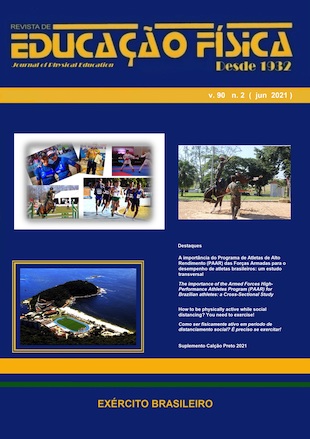Resumo
Introdução: Uma epidemia por coronavírus começou em novembro de 2019 (COVID-19) na cidade chinesa de Wuhan. Contudo, o cenário atual evidencia a coexistência de outras pandemias: da prática insuficiente de atividade física e da obesidade. E o efeito desta combinação tende a potencializar as complicações atribuídas à infecção por coronavírus. Diante deste cenário, dentre outras estratégias de combate ao COVID-19, recomenda-se o distanciamento social e a adoção de um estilo de vida compatível com uma boa saúde imunológica.
Objetivo: O presente comentário teve como objetivo considerar o impacto da pandemia do COVID-19 sobre o nível de atividade física da população e recomendar a prática de exercícios físicos.coronavírus. Diante deste cenário, dentre outras estratégias de combate ao COVID-19, recomenda-se o distanciamento social e a adoção de um estilo de vida compatível com uma boa saúde imunológica.
Conclusão: A atividade física para atender às recomendações recentes da Organização Mundial da Saúde e otimizar a resposta imune deve ser de intensidade moderada, logo, deve-se incluir a prática dos exercícios físicos no cotidiano, principalmente com possibilidades de realização em domicílio, particularmente em períodos de maior distanciamento social.
Referências
Fehr AR, Perlman S. Coronaviruses: an overview of their replication and pathogenesis. Methods in Molecular Biology. [Online] 2015;1282:1-23. Available from: doi:10.1007/978-1-4939-2438-7_1.
World Health Organization. Available from: https://www.who.int/director-general/speeches/detail/who-director-general-s-opening-remarks-at-the-media-briefing-on-covid-19---11-march-2020. [Accessed: 11th June 2021].
World Health Organization. Coronavirus disease (COVID-19). Situation dashboard. Available from: https://covid19.who.int/. [Accessed: 11th June 2021].
Nieman DC. Coronavirus disease-2019: A tocsin to our aging, unfit, corpulent, and immunodeficient society. Journal of Sport and Health Science. [Online] 2020;9(4): 293–301. Available from: doi: 10.1016/j.jshs.2020.05.001.
Martinez-Ferran M, de la Guía-Galipienso F, Sanchis-Gomar F, Pareja-Galeano H. Metabolic Impacts of Confinement during the COVID-19 Pandemic Due to Modified Diet and Physical Activity Habits. Nutrients. [Online] 2020;12(6):1549. Available from: doi:10.3390/nu12061549.
Schwendinger F, Pocecco E. Counteracting Physical Inactivity during the COVID-19 Pandemic: Evidence-Based Recommendations for Home-Based Exercise. International Journal of Environmental Research and Public Health. [Online] 2020;17(11):3909. Available from: doi:10.3390/ijerph17113909.
Caspersen CJ, Powell KE, Christenson GM. Physical activity, exercise, and physical fitness: definitions and distinctions for health-related research. Public Health Reports. [Online] 1985;100(2):126-131.
Filgueira TO, Castoldi A, Santos LER, et al. The Relevance of a Physical Active Lifestyle and Physical Fitness on Immune Defense: Mitigating Disease Burden, With Focus on COVID-19 Consequences. Frontiers in Immunology. [Online] 2021;12:587146. Available from: doi:10.3389/fimmu.2021.587146.
Sallis R, Young DR, Tartof SY, et al. Physical inactivity is associated with a higher risk for severe COVID-19 outcomes: a study in 48 440 adult patients [published online ahead of print, 2021 Apr 13]. British Journal of Sports Medicine. [Online] 2021;bjsports-2021-104080. Available from: doi:10.1136/bjsports-2021-104080
Zbinden-Foncea H, Francaux M, Deldicque L, Hawley JA. Does High Cardiorespiratory Fitness Confer Some Protection Against Proinflammatory Responses After Infection by SARS-CoV-2?. Obesity (Silver Spring). [Online] 2020;28(8):1378-1381. Available from: doi:10.1002/oby.22849.
Pišot R, Marusic U, Biolo G, et al. Greater loss in muscle mass and function but smaller metabolic alterations in older compared with younger men following 2 week of bed rest and recovery. Journal of Applied Physiology (Bethesda, Md. : 1985). [Online] 2016;120(8):922-929. Available from: doi:10.1152/japplphysiol.00858.2015.
Bhutani S, Cooper JA. COVID-19-Related Home Confinement in Adults: Weight Gain Risks and Opportunities. Obesity (Silver Spring). [Online] 2020;28(9):1576-1577. Available from: doi:10.1002/oby.22904.
Krogh-Madsen R, Thyfault JP, Broholm C, et al. A 2-wk reduction of ambulatory activity attenuates peripheral insulin sensitivity [published correction appears in Journal of Applied Physiology. 2010;108(5):1034]. Journal of Applied Physiology (Bethesda, Md. : 1985). [Online] 2010;108(5):1034-1040. Available from: doi:10.1152/japplphysiol.00977.2009.
Pedersen BK. Muscles and their myokines. The Journal of Experimental Biology. [Online] 2011;214(Pt 2):337-346. Available from: doi:10.1242/jeb.048074.
Kohl HW 3rd, Craig CL, Lambert EV, et al. The pandemic of physical inactivity: global action for public health. Lancet (London, England). [Online] 2012;380(9838):294-305. Available from: doi:10.1016/S0140-6736(12)60898-8.
Hallal PC, Andersen LB, Bull FC, et al. Global physical activity levels: surveillance progress, pitfalls, and prospects. Lancet (London, England). [Online] 2012;380(9838):247-257. Available from: doi:10.1016/S0140-6736(12)60646-1.
Ministry of Health. Vigitel Brazil 2019: surveillance of risk and protective factors for chronic diseases by telephone survey: estimates of frequency and sociodemographic distribution of risk and protective factors for chronic diseases in the capitals of the 26 Brazilian states and the Federal District in 2019. Available from: http://bvsms.saude.gov.br/bvs/publicacoes/vigitel_brasil_2019_vigilancia_fatores_risco.pdf. [Accessed: 11th June 2021].
Souza Filho BAB, Tritany ÉF. COVID-19: the importance of new technologies for physical activity as a public health strategy. COVID-19: importância das novas tecnologias para a prática de atividades físicas como estratégia de saúde pública. Cadernos de Saude Pública. [Online] 2020;36(5):e00054420. Available from: doi:10.1590/0102-311x00054420.
Costa RF. Can physical activity help in the fight against CoViD-19? Revista de Educação Física / Journal of Physical Education. [Online] 2020;89(4): 224–227.
Martins L, Soeiro R. Exercise and CoViD-19: Health, Prevention and Recovery Aspects: A Brief Narrative Review. Revista de Educação Física / Journal of Physical Education. [Online] 2020;89(4): 240–250.
World Health Organization. WHO guidelines on physical activity and sedentary behaviour. Available from: https://apps.who.int/iris/handle/10665/336656. [Accessed: 11th June 2021].
American College of Sports Medicine; Riebe D, Ehrman JK, Liguori G, Magal M, organizadores. ACSM’s guidelines for exercise testing and prescription. 10th ed. Philadelphia - USA: Wolters Kluwer; 2018.
Pollock ML, Wilmore JH. Exercícios na saúde e na doença: avaliação e prescrição para prevenção e reabilitação. São Paulo: Medsi; 1993. 718 p.
Ainsworth BE, Haskell WL, Whitt MC, et al. Compendium of physical activities: an update of activity codes and MET intensities. Medicine and Science in Sports and Exercise. [Online] 2000;32(9 Suppl):S498-S504. Available from: doi:10.1097/00005768-200009001-00009.
Farinatti PTV. Apresentação de uma versão em português do compêndio de atividades físicas: uma contribuição aos pesquisadores e profissionais em fisiologia do exercício. Revista Brasileira de Fisiologia do Exercício (Rio de Janeiro). 2003;2(2): 177-208.
Corpo Editorial REF/JPE. Physical Exercise and Covid-19 – The Role of Physical Exercise for Health and Recovery: An Article View Presenting the work of Silveira et al. Revista de Educação Física / Journal of Physical Education. [Online] 2020;89(3): 184–188.

Este trabalho está licenciado sob uma licença Creative Commons Attribution 4.0 International License.
